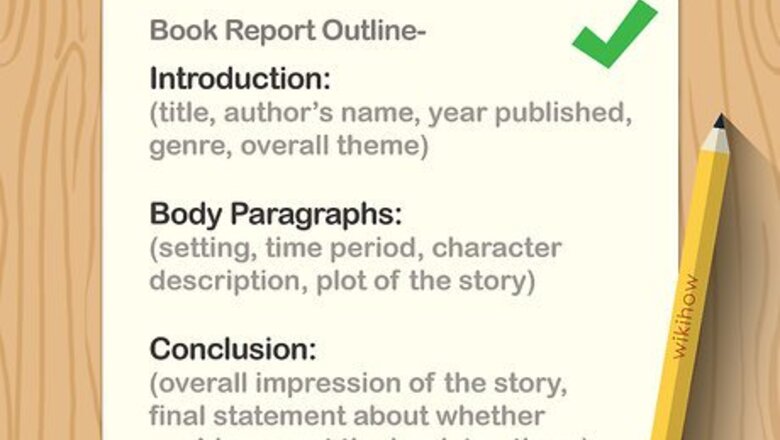
views
Preparing for Your Book Report
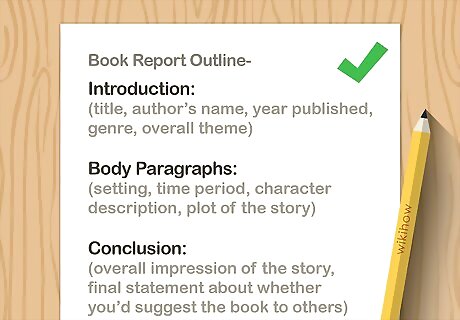
Pick an appropriate book. Your teacher may assign a book to you, or give you a list from which to choose. If she/he doesn't give you a specific book, you may find it helpful to ask your school librarian to recommend something that's appropriate for the assignment. If you can, pick a book on a topic that interests you, as this will make it more enjoyable for you to read.

Make sure you understand the assignment. Your teacher may give you an assignment or prompt that gives you specific details on the book report. Be sure you follow all the guidelines given, such as how long the report needs to be and what it needs to include. Don't confuse a book report with a book review. A book report typically summarizes a book and may offer your opinion on a book, but it usually focuses more on facts about the book. A book review usually describes what a book says and evaluates how the book works. If you have any questions, ask your teacher. It's much better to ask questions when you don't understand something than to try to muddle through only to produce work that isn't what your teacher expected.
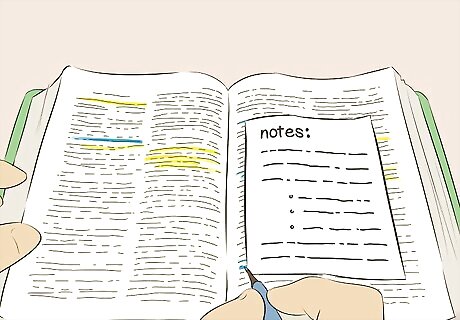
Take notes while you read. It will be much easier to draft your book report if you've taken notes as you go along, rather than trying to remember everything at the end. As you read, jot down a few notes on the following: Characters. If your book is fiction (or a biography or memoir), keep track of who the major characters are. What are they like? What do they do? Are they different at the end of the book than the beginning? Did you like them? Setting. This category mainly applies to fiction. The setting of a book is where and when the story takes place (for example, the Harry Potter novels' main setting is the school of Hogwarts). The setting may have significant influence on the characters and the story. Story. What happens in the book? Who did what? Where in the book (beginning, middle, end) do important things seem to happen? Were there any clear “turning points” in the story, where things seem to change from what came before? How did the story resolve? What parts are your favorite parts of the story? Main ideas/themes. This category will be slightly different for nonfiction or fiction. Nonfiction may have a very clear main idea, such as presenting a biography of a famous historical figure. For fiction, there will probably be a key theme that runs throughout the book. Think about this in terms of what you learned from the book that you didn't know before reading it. You may find it easier if you take a few notes on each chapter. Quotations. A good book report not only tells, but shows. For example, if you really enjoyed the author's writing style, you could use a quotation in your book report that shows why you liked it. A juicy quote that sums up the main idea of the book could also be a good idea. You don't have to use every quotation that you write down in your report, but jot down any quotations that catch your attention.
Drafting Your Book Report
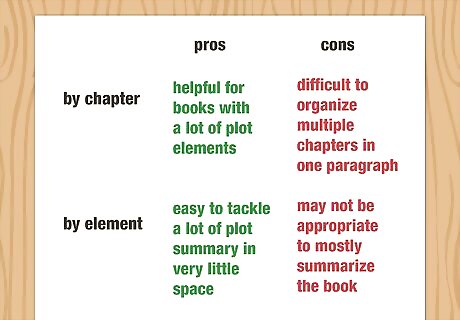
Decide how to organize your book report. Your teacher may have given you specific requirements, and if so, you should follow those. There are two basic ways to organize a book report: Organize the book report by chapter. If you organize your book report this way, you will move from chapter to chapter. You'll probably need to cover multiple chapters in each paragraph. Pro: You can go in chronological order, which could be helpful when you're summarizing books with a lot of plot elements. Con: This kind of organization can be more difficult to figure out if you need to talk about multiple chapters in one paragraph. Organize the book report by type of element ("thematic" organization). If you organize your book report this way, you could have a paragraph about the characters, a paragraph or two about plot summary, a paragraph about main ideas, and a paragraph that sums up your opinion of the book. Pro: You can tackle a lot of plot summary in very little space. The paragraphs are clearly divided, so you know what to cover in each one. Con: This may not be appropriate if your assignment is mostly to summarize the book rather than give your opinions about it.
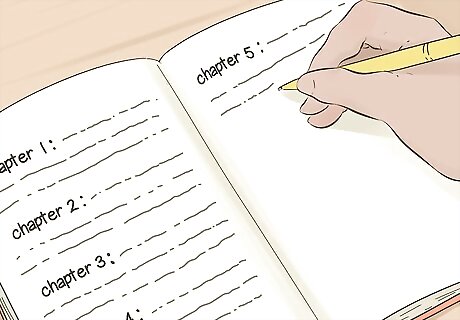
Create an outline. This will help you draft your summary. Put your notes into outline form depending on how you decided to organize your paragraphs. For chronological order: Give each chapter or section of the book its own section. Write down the most important story elements and character developments that happened in each chapter. For thematic organization: Put your notes about the various elements, such as characters, plot, and main ideas, into separate sections. Each will become a paragraph. When you write your first draft, think about what elements move the story forward, because those will probably be the most important. You can give more detail as you revise, if you want. For example, many things happen in Suzanne Collins's The Hunger Games, but you can't talk about them all. Instead, focus on the overall movement of the story. Begin by explaining what the Hunger Games are and how Katniss Everdeen and Peeta Mellark are chosen. Then you would summarize their time in the Capitol, including information on how sponsorship works. Following that, you would summarize the most important moments from the Games, such as Katniss injuring her leg in the fire, the attack by tracker-jackers, Rue's death, the kiss in the cave, Cato's final battle, and the decision to eat the poisonous berries. Then, you would conclude by wrapping up the most important moments from the book's ending.
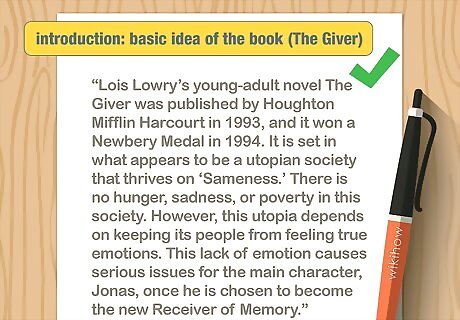
Write your introduction paragraph. Your introduction should give the reader a basic idea of what the book is about. It should also give a little bit of information about its main characters and/or ideas. You don't have to go into a lot of detail here; you just need to give enough information that your reader knows what to expect from the rest of the report. Give publication information for the book, including the book's title, author, year of publication, and genre. Your teacher may ask you to include other information. If your book was written by someone important, won an award, or is a best-seller, give that information too. For example, a short overall summary of Lois Lowry's The Giver might look something like this: “Lois Lowry's young-adult novel The Giver was published by Houghton Mifflin Harcourt in 1993, and it won a Newbery Medal in 1994. It is set in what appears to be a utopian society that thrives on 'Sameness.' There is no hunger, sadness, or poverty in this society. However, this utopia depends on keeping its people from feeling true emotions. This lack of emotion causes serious issues for the main character, Jonas, once he is chosen to become the new Receiver of Memory.” For a nonfiction book, summarize the author's main idea or purpose for writing the book. State what you think their thesis is. For example, a short overall summary for the book I Am Malala might look like this: “The youngest recipient of the Nobel Peace Prize, Malala Yousafzai tells her incredible true story in I Am Malala: The Girl Who Stood Up for Education and Was Shot by the Taliban. This book was published by Little, Brown and Company in 2013. Malala wants to inspire other young people to believe in their power to change the world by sharing her own experience about the value of education and peaceful protest.”
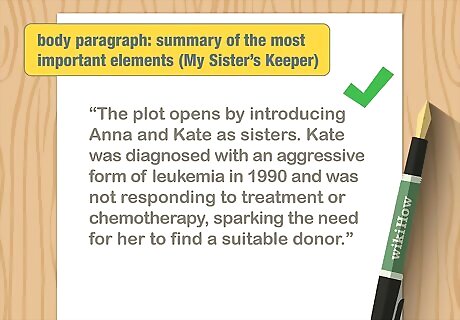
Develop your body paragraphs. Working from your outline, develop body paragraphs that summarize the most important elements of the book. Unless you're dealing with a very short book, you almost certainly won't be able to summarize every detail or even every chapter in your final draft. Instead, focus on what seemed most important to you about the story and the characters. For nonfiction, your summary should focus on what you think the author's main idea is and how that idea is developed in the book. What important points does the author make? What evidence or stories from their personal experience do they use to support their points?
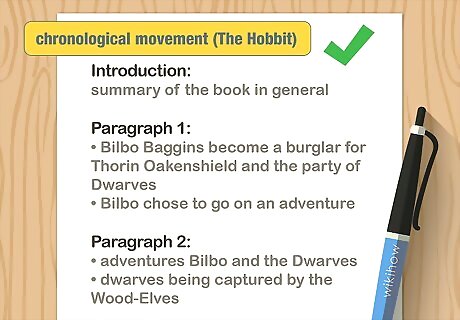
Use the movement of the plot to help you develop your paragraphs. If you've chosen to organize your book report chronologically, think about how the plot moves along. What are the major events in the plot? Where do things change? Where are the surprises or cliff-hangers? Break up your paragraphs based on where the important events happen. For example, if you were summarizing J.R.R. Tolkien's novel The Hobbit, you might organize your paragraphs this way: Introductory paragraph: summarize the book in general and gives the publication information. Body paragraph 1: summarize Gandalf's plot to get Bilbo Baggins to become a burglar for Thorin Oakenshield and the party of Dwarves. End with Bilbo's choosing to go on an adventure (because this is a major changing point for the character). Body paragraph 2: summarize the adventures Bilbo and the Dwarves have, such as almost being eaten by trolls, getting kidnapped by goblins, and Bilbo finding Gollum and the One Ring. There are a lot of adventures, so you wouldn't talk about them all; instead, pick the most important points. You might end with the Dwarves being captured by the Wood-Elves, because this is another "turning point" in the story. Bilbo has to decide whether he is brave enough to rescue everyone. Body paragraph 3: summarize the interactions between the Dwarves and the Lake Town people, Bilbo getting into the Lonely Mountain and talking to Smaug, Smaug destroying everything and getting killed (spoiler!), and the many groups of Dwarves, Elves, and Men deciding to fight over the spoils. This is a good place to stop this paragraph, because it's the climax of the story and your reader wants to know the resolution, or how everything turns out okay. Body paragraph 4: summarize how Bilbo tries to stop the fighting, the argument Bilbo and Thorin have, the outcome of the battle, and Bilbo coming home to discover all of his stuff is being sold off. You can also talk about how the main character, Bilbo, ends up as a different character than the way he started off. That would be a good transition into... Conclusion paragraph: talk about the main ideas of the book and what you learned. You might talk about how important it is to learn to be brave, or how greed is criticized in the book. Then, wrap up with your opinion about the book overall. Would you recommend it to a friend?
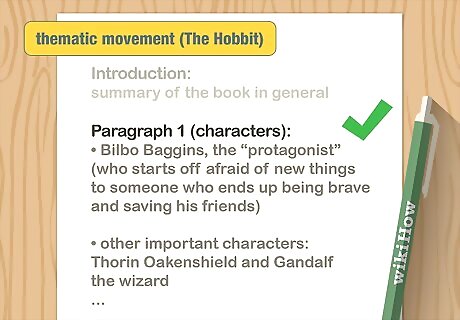
Organize your paragraphs by theme. If you've chosen thematic organization, you can develop your paragraphs according to topic instead of letting the plot determine your paragraphs. You'll want a paragraph (or two) of plot summary, a paragraph about the characters, a paragraph about the book's main ideas or themes, and a paragraph that sums up your overall opinion. Begin with a VERY brief plot summary. Talk about the type of book it is, where the book is set (Hogwarts, outer space, a mythical past), what the main character is trying to do or learn, and how the plot ends up. The paragraph about characters should talk about the main character (or characters). Who are they, and why are they important? What do they want to do or learn? What flaws and strengths do they have? Do they end the book as different in some way than how they began? For example, a paragraph about the characters in The Hobbit would probably focus the most on Bilbo Baggins, the "protagonist" or hero of the novel. It would probably also need to talk a little bit about the other important characters: Thorin Oakenshield and Gandalf the wizard. This paragraph would consider Bilbo's character development from someone who starts off afraid of new things to someone who ends up being brave and saving his friends. The paragraph about the main ideas or themes might be the hardest one to write, but your notes should help. Think about what lessons the characters have learned. What did this book make you think about? Did it make you ask questions? For example, if you were writing about The Giver, you might want to discuss the importance of feelings in human lives. You could also talk about the idea that in order to experience life fully, you have to experience pain as well as pleasure. Another big theme is the idea of becoming your own person: the hero Jonas has to learn how to reject the "Sameness" of society to follow his own path.
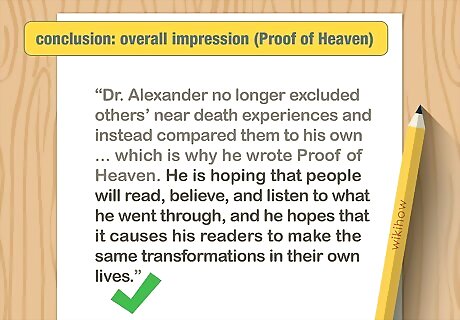
Write a conclusion. Your conclusion should wrap up by reviewing the main points of the book and giving your opinion of the book. Did you like it? Was it enjoyable? Do you agree with the author's ideas or ways of writing? Did you learn something you didn't know before? Explain your reasons for your reaction, using examples to support your claims. Imagine your conclusion as a way of telling others whether they should read the book or not. Would they enjoy it? Should they read it? Why or why not?
Revising Your Book Report
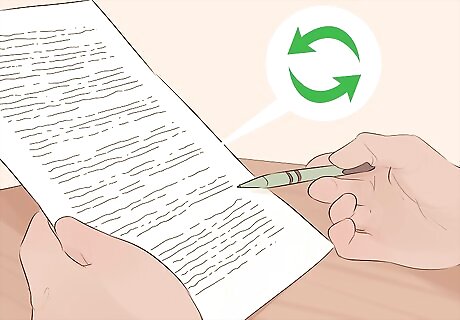
Reread your book report. You should have a clear structure in your report, with an introduction that provides a short summary of the book's main points, body paragraphs that clearly summarize the book, and a conclusion that provides an overall assessment of the book. As you read, ask yourself: if you were telling this summary to a friend who hadn't read the book, would they understand what happened? Would they have a good idea of whether or not they would like the book?
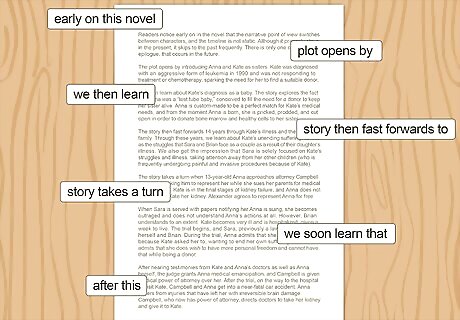
Check for logical transitions. You need transitions between your paragraphs, and also between each idea in each paragraph. These transitions help guide your reader along as they learn about what happens. For example, instead of beginning sentences with just the word “This” or “It,” remind your reader what happened in the previous sentence. “This” is vague, but “This (contest, lottery, murder)” is clear.
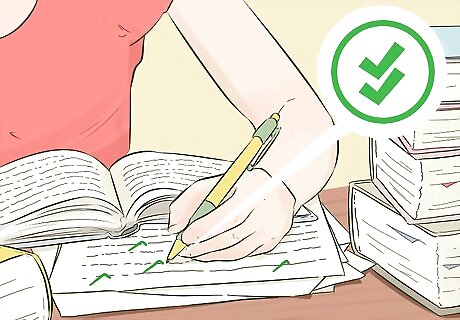
Double-check all of the information about the book. Make sure you've spelled the author's and characters' names correctly, given the complete and full title, and provided the publisher of the book (if your teacher asked for it).
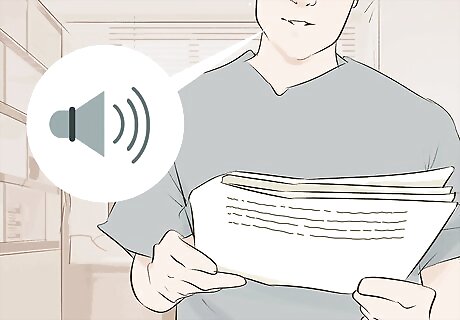
Read the book report aloud. This will help you catch any awkward spots or places that seem hard to understand. Reading aloud will also help you catch proofreading errors that need correcting.
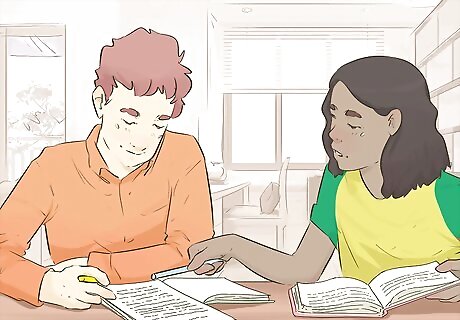
Ask someone else to read your report. The best way to know whether you've done a good job summarizing the important parts of your book is to ask someone else to read your book report. A friend or a parent can help you find the places that are unclear. Don't tell your friend what the book is about or what you're focusing on before you have them read your report. That way, they will have to focus only on what's on the paper -- which is what your teacher will be doing too.
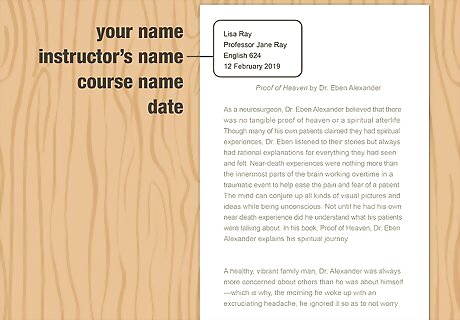
Make sure your name and your teacher's name are on the final copy. This is important whether you're turning in a printed copy or a handwritten copy. If you don't put your name on the book report, your teacher won't be able to give you a grade
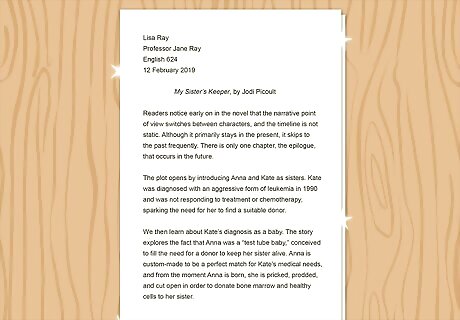
Make a clean copy on good paper. If you're printing out your book report from a computer, use clean, heavy-duty paper in the printer. Keep the book report from getting wrinkled before you turn it in. If you're hand-writing your book report, use your nicest, most easy-to-read handwriting and clean, unwrinkled paper.

Celebrate! You've done a good job. Be proud of your hard work!













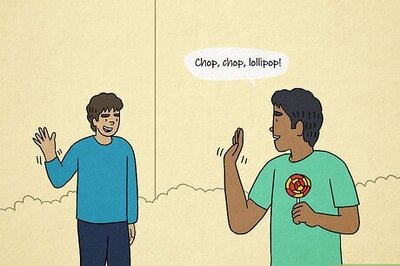




Comments
0 comment